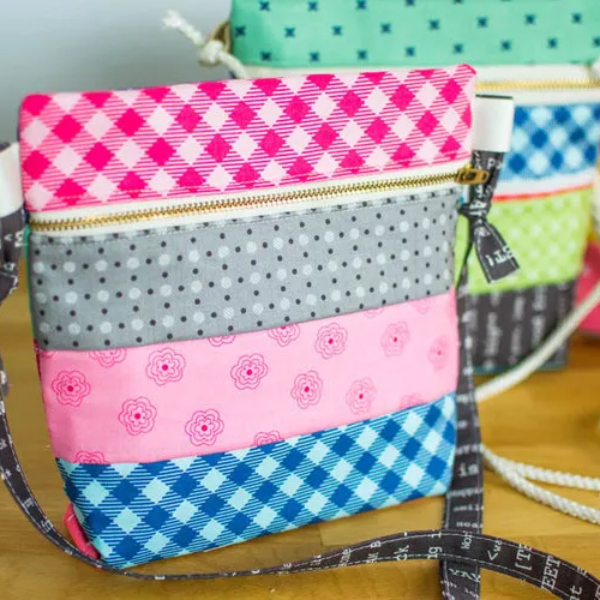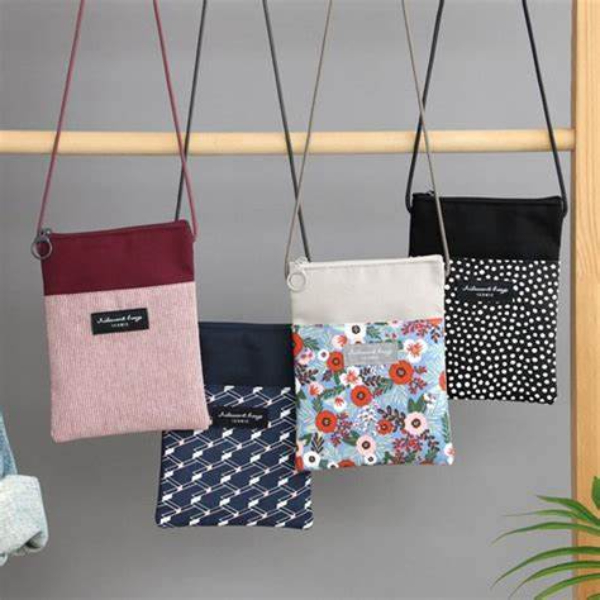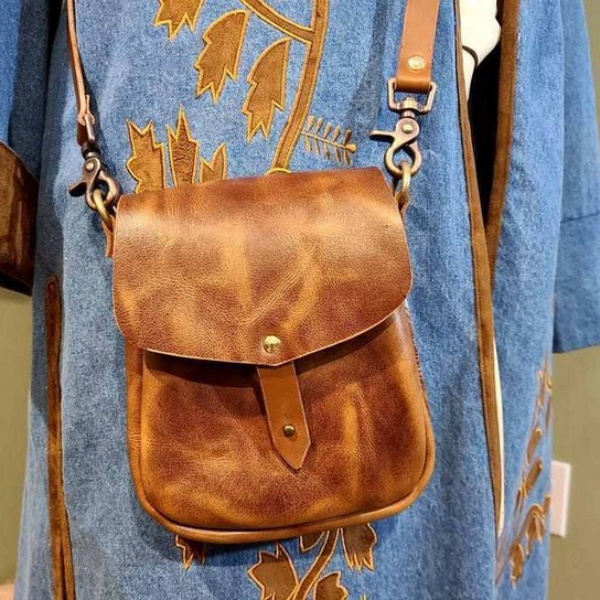
Essential Materials and Tools
To embark on your DIY crossbody bag project, gather the necessary materials and tools first. Here’s a quick rundown of what you’ll need:
- Fabric for the exterior: Pick a durable material like upholstery or heavy-weight cotton.
- Lining fabric: Quilting cotton works well for a soft interior.
- Interfacing: Choose lightweight for the lining and heavy-weight for the exterior, to give your bag structure.
- Zippers: At least one metal zipper for the main compartment.
- Hardware: D-rings, slide buckle, and a closure such as a tongue lock or magnetic snap.
- Thread: Color-matched to your fabric.
- Sewing machine and scissors: Essential for cutting and stitching your bag.
- Pins or clips: For holding fabric pieces together as you sew.
- Iron: To press the fabric for crisp seams and to apply interfacing.
Opt for tools that match your skill level. Beginners may find clips easier to handle than pins, for instance. Having the right materials at hand ensures your DIY project goes smoothly from start to finish.

Choosing the Right Fabric and Interfacing
Selecting appropriate materials is a crucial step when creating a DIY crossbody bag. For the exterior fabric, consider its durability and the type of use your bag will endure. Upholstery or heavy-weight cotton are great choices providing both sturdiness and style. For the interior lining of your bag, quilting cotton is an excellent option due to its softness and wide range of patterns. When selecting materials for your DIY crossbody Goyard bag, prioritize durability for the exterior and softness for the interior lining to achieve both style and functionality.
Next, let’s talk about interfacing. This is the middle layer that offers structure and form to your bag. You have two main types to choose from:
- Lightweight interfacing for the lining, which provides a slight stiffness while maintaining the lining’s suppleness.
- Heavy-weight interfacing for the exterior, giving the bag the rigidity needed to hold its shape. Iron-on interfacing is commonly used as it can be easily attached to the fabric with heat from an iron.
The interfacing should be applied to the wrong side of your fabric pieces before you start sewing. This step is critical for areas that need extra support, like where the bag will have closures or where straps will attach. Remember to trim any excess interfacing after application to reduce bulk in the seams.
Your choice of fabric and interfacing will greatly influence the final look and feel of your DIY crossbody bag. Consider the bag’s intended use and personal style preference to make an optimal selection.
Cutting Your Fabric to Size
Before you begin sewing, you must cut your fabric according to the bag’s design. Here’s how to do it precisely:
- Measure carefully: Use a ruler or measuring tape to measure the dimensions of your bag’s pattern pieces. Ensure you have all the correct measurements for the body, flap, strap, and pockets.
- Mark the fabric: After measuring, mark the cutting lines on your fabric with a fabric marker or tailor’s chalk. This will be your guide for cutting.
- Integrate seam allowances: Don’t forget to add extra space for seam allowances around each piece. Usually, a 3/8 inch seam allowance is standard unless otherwise noted.
- Cut accurately: Use sharp fabric scissors or a rotary cutter for clean, straight edges. For the exterior, lining, and pocket fabrics, follow your marks and cut one of each piece needed.
- Don’t rush: Take your time to ensure each piece is cut correctly to avoid mistakes that could affect your bag’s final look.
Properly cut fabric pieces are the foundation of your DIY crossbody bag, leading to a neatly assembled and professional-looking final product.
Sewing the Bag’s Exterior and Lining
Once you have cut your fabric pieces, it’s time to sew the exterior and lining of your DIY crossbody bag. This step is where your project begins to take shape, so closely follow each instruction for the best results.
Preparing the Exterior
Start with the exterior fabric pieces you’ve cut. Lay them out and ensure you have the body, flap, and any additional elements like exterior pockets. Pin these pieces right sides together, matching all edges. Sew around the pieces using a straight stitch, but remember to leave an opening for turning the bag right side out later. This opening is crucial for assembling your bag. When making the best crossbody bag for travel in Europe, ensure you leave an opening to turn it right side out for a polished finish. Proper assembly is key for functionality!

Crafting the Lining
Next, you’ll tackle the lining. Just like with the exterior, take your cut lining pieces and pin them right sides together. Sew them carefully, adding a zipper or pockets if your design calls for them. For pockets, line them up on the right side of one lining piece before sewing the other on top. Make sure the zipper functions smoothly by testing it before sewing it in place.
Combining Exterior and Lining
With both the exterior and lining stitched, press all seams flat with an iron. This will give your bag a polished look. Then, place the exterior inside the lining with right sides facing each other, aligning the seams and edges. This encases the raw edges for a clean finish inside the bag. Stitch around the top edge, leaving the earlier mentioned gap for turning.
Finalizing Structure
After sewing, carefully turn the bag right side out through the gap. Poke out corners for a defined shape. Press the edges and sew the gap closed, either with a discreet hand stitch or a close edge top-stitch. With this, the main body of your crossbody bag is essentially complete, setting the stage for further embellishments and functional components. After finishing your crossbody bag, consider creating a matching travel makeup bag for an organized and stylish accessory. Both pieces can enhance your travel experience with functionality and flair.
This sewing process sets the foundation for a durable and stylish crossbody bag. In the following sections, we’ll explore how to add more functionality and personalized touches to your creation.
Adding Pockets and Zippered Compartments
When designing your DIY crossbody bag, adding pockets and compartments enhances functionality and style. Here’s how to include these practical features:
Plan Your Pockets
Decide where you want your pockets. Common options include the outer front for easy access, the back for added security, or the lining for concealed storage. Remember your pocket sizes should suit what you plan to carry.
Attach Zippered Compartments
For zippered compartments, cut fabric pieces slightly larger than your zipper length. Sew the zipper between these pieces. Then, stitch this unit onto your chosen bag section. Use pins or clips to hold it steady while you sew.
Sew Pockets to Lining or Exterior
To add a pocket to the lining, place the pocket piece over the lining fabric. Sew around three sides, leaving the top open. For an exterior pocket, repeat this step, but consider adding a flap or zipper for security.

Customize Pocket Size and Shape
You can tailor pockets to fit specific items like a phone or sunglasses. Just adjust the dimensions as needed. Cut, pin, and sew according to your new measurements. Curved or angled pockets can add visual interest.
By following these steps, your custom crossbody bag will not only have a unique look but also offer personalized functionality, keeping items organized and within reach.
Crafting and Attaching the Strap
Creating a strap for your DIY crossbody bag is essential for functionality and comfort. Here’s a simple guide to craft and attach the ideal strap:
Selecting Strap Fabric
Choose a fabric that complements your bag and can withstand the weight of its contents. Heavy-weight cotton or upholstery fabric are robust options.
Cutting the Strap
Measure and cut a long strip for the strap. The standard width is about 2 inches, allowing for a comfortable shoulder fit. Don’t forget to include seam allowances on all sides.
Sewing the Strap
Fold the edges of the strap towards the middle and press with an iron. Then fold it in half lengthwise, pressing again for a neat finish. Stitch along the edges to secure.
Attaching Hardware
Attach D-rings to the ends of the strap by threading them through and sewing the ends shut. This method creates a loop that the rings can move freely on.
Fixing the Strap to the Bag
To connect the strap to your bag, you’ll need swivel hooks and a slide buckle. Secure one end of the strap to a swivel hook by sewing. Repeat with the other end, threading the slide buckle before attaching the hook.
Adjusting Strap Length
The slide buckle allows you to adjust the length of your strap easily. Thread the strap through the buckle following its design, ensuring a snug fit that stays in place.
Final Attachment
Clip the swivel hooks to the D-rings that are attached to your bag. Now, your crossbody bag has a functional, adjustable strap tailored to your body size and carrying preferences.
By carefully crafting and attaching the strap, you ensure that your DIY crossbody bag is both practical and personal. Use the steps above to add a custom strap that enhances your bag’s design and usability.
Assembling the Bag: Bringing it All Together
Once you have your bag’s exterior, lining, pockets, and strap ready, it’s time to assemble everything. The assembly stage is where your crossbody bag truly takes shape. Here’s a step-by-step guide to bring all the parts together to complete your DIY project:
- Attach the Exterior to the Lining: Turn the exterior of the bag right side out and the lining inside out. Place the exterior inside the lining, so that right sides are facing each other.
- Align Seams and Edges: Match the side seams and top edges of both the lining and exterior. Use clips or pins to hold them in place.
- Stitch Around the Top: Sew around the top edge of the bag, leaving an opening for turning. Make sure to backstitch at the start and end for extra strength.
- Turn the Bag Right Side Out: Through the opening you left, gently pull the exterior fabric through to the right side. Push out corners and smoothen the edges for a nice finish.
- Sew the Opening Closed: Once your bag is right side out, fold the edges of the opening inwards and pin. Top-stitch to close or hand stitch for a more hidden seam.
- Press the Bag: Use an iron to press the seams and edges neatly. This gives your crossbody bag a professional, crisp appearance.
- Attach the Zipper: If your design includes a zipper, now is the time to add it. Sew it in place, ensuring it operates smoothly.
- Attach the Strap: Finally, clip the swivel hooks of your strap onto the D-rings secured to the bag. Adjust the slide buckle to your preferred strap length.
Voilà! You’ve just completed your very own DIY crossbody bag. It’s not only a stylish accessory but also a testament to your craftsmanship. Enjoy the fruits of your labor and wear your new bag with pride.
Finishing Touches and Accessorizing Your Bag
Now that your DIY crossbody bag is assembled, it’s time to give it a personal touch. This is where you transform a simple bag into your unique fashion statement. Here’s how to add those finishing touches:
Customize with Decorative Elements
Add personality with buttons, patches, or embroidery. Choose accents that reflect your style. You can stitch them on, or use fabric glue for a no-sew option.
Paint or Dye Your Bag
For a splash of color, try fabric paints or dyes. They’re fun to use and can change the look dramatically. Always follow the instructions and allow proper drying time.
Create a Lining with a Pop
Surprise inside! Pick a lining in a bright color or with a fun pattern. It makes finding items easier and starts conversations.
Add Interior Organization
Maximize space by sewing in extra pockets or dividers. Use mesh or clear plastic for see-through storage. Simple pockets can hold pens or a notepad.
Attach a Key Fob
Never lose keys again. Sew a short ribbon or sturdy string to one side of the lining. Attach a hook at the end for your keys.
Adjustable Strap Tips
Ensure comfort by adjusting the strap to sit right. It should feel snug but not tight. Change the length for different looks or uses.
Test and Tweak
Use your bag for a day. Notice how it feels and works. Make adjustments based on your experience. Personal tweaks make it perfect for you.
With creativity, you can make a crossbody bag that’s truly one-of-a-kind. Enjoy your new creation and the compliments that come with it.